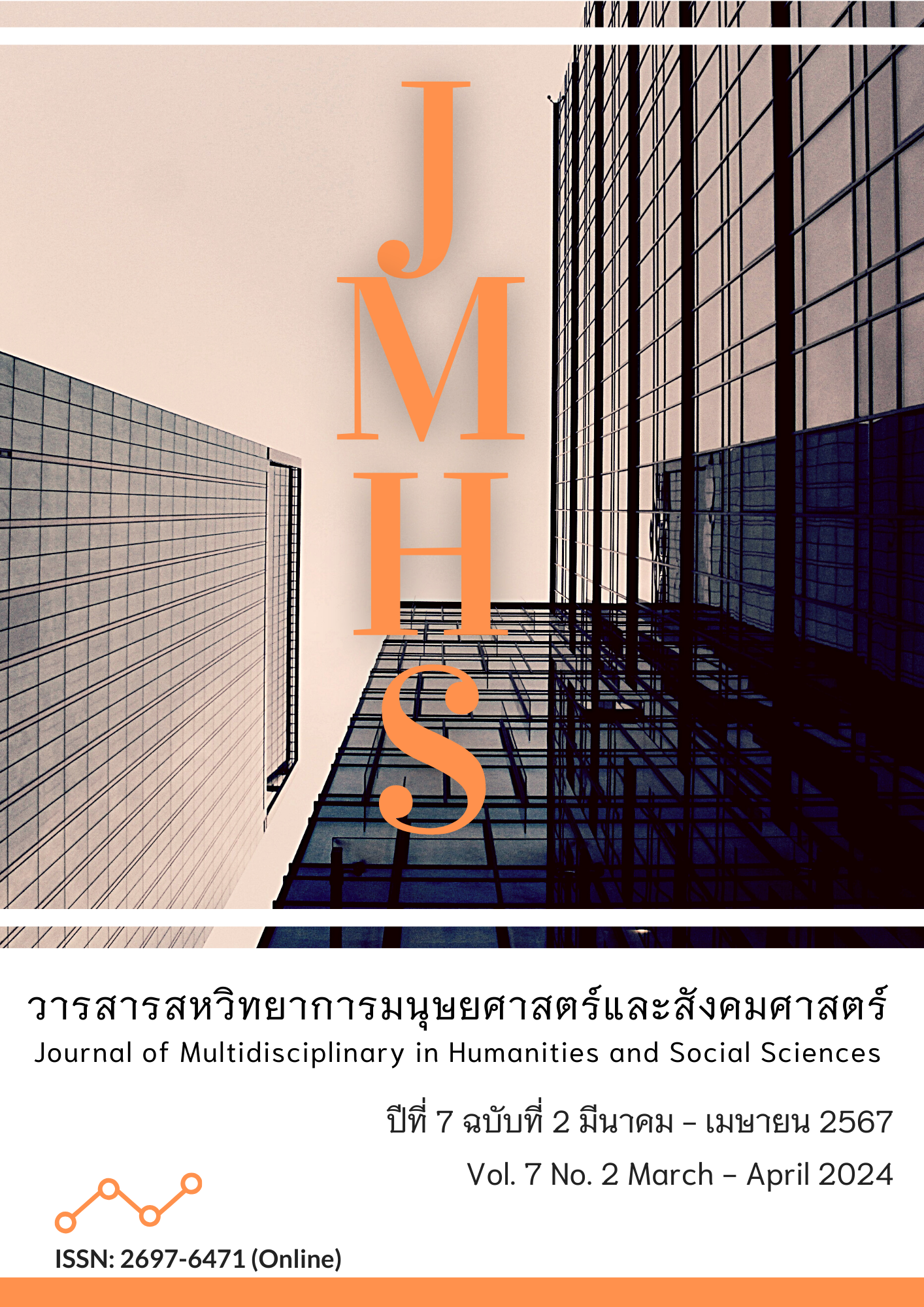Technological Leadership Model Based on Vuddhidhamma Principles for Educational Institution Administrator under the Office of Secondary Educational Service Area
Main Article Content
Abstract
This article aimed 1) to study the needs of technological leadership of educational institution administrators under the jurisdiction of the Secondary Educational Service Area Office, 2) to develop a technological leadership model based on the 4 principles of Vuddhidhamma for educational institution administrators under the jurisdiction of the Secondary Educational Service Area Office, and 3) to evaluate the technological leadership model according to the 4 principles of Vuddhidhamma for educational institution administrators under the jurisdiction of the Secondary Educational Service Area Office. The study uses an integrated research method. The research was carried out in 3 steps: Step 1: To study the needs of technological leadership of educational institution administrators. A questionnaire was used for a sample of 364 teachers in educational institutions. The data were analyzed by using statistics such as frequency, percentage, mean, standard deviation and necessary needs (PNIModified). Step 2: To develop a model by using interviews with 10 key-informants through a semi-structured questionnaire and group discussions with 9 experts with group discussion questions. The data were analyzed by using content analysis. And step 3: To evaluate the model by using an evaluation form for a sample of 92 educational institution administrators. The data were analyzed by using statistics, including frequency, percentage, mean, and standard deviation.
The results of the study found that: 1. Requirements for technological leadership of educational institution administrators under the Secondary Educational Service Area Office were found that the highest need index was having technological vision, followed by using technology in teaching, supporting, managing and operating technology and the use of technology in measurement and evaluation, respectively. 2. A technological leadership model based on the 4 principles of Vuddhidhamma for educational institution administrators under the jurisdiction of the Secondary Educational Service Area Office consists of 5 elements. 3. Assessment of the technological leadership model according to the 4 principles of Vuddhidhamma for educational institution administrators under the jurisdiction of the Secondary Educational Service Area Office, the evaluation results were at the highest level overall. When considering each aspect, the evaluation results were at the highest level in all 4 areas, namely usefulness, appropriateness, correctness, and feasibility, respectively. In summary, the body of research knowledge is concluded into TIVAVA. T stands for Technological leadership, I for Innovation, V for Vision, A for Administration, V for Vuddhidhamma, and A for Application.
Article Details

This work is licensed under a Creative Commons Attribution-NonCommercial-NoDerivatives 4.0 International License.
Views and opinions appearing in the Journal it is the responsibility of the author of the article, and does not constitute the view and responsibility of the editorial team.
References
กัลยาวรรธน์ ตะเภาทอง, สถิรพร เชาวน์ชัย และ วิทยา จันทร์ศิลา. (2565). แนวทางการพัฒนาภาวะผู้นำเชิงเทคโนโลยีของผู้บริหารโรงเรียนขยายโอกาส สังกัดสำนักงานเขตพื้นที่การศึกษาประถมศึกษาพิจิตร เขต 1. Journal of Modern Leaming Development, 7(2), 41-55. สืบค้นจาก https://so06.tci-thaijo.org/index.php/jomld/article/view/253667
จิราพัชร ไผ่วุฒิพันธ์, ปพนสรรค์ โพธิพิทักษ์ และ ทีปพิพัฒน์ สันตะวัน. (2565). การวิเคราะห์องค์ประกอบภาวะผู้นำเชิงเทคโนโลยีของผู้บริหารสถานศึกษา สังกัดสำนักงานเขตพื้นที่การศึกษามัธยมศึกษานครสวรรค์, วารสารรัชต์ภาคย์, 16(44), 236-250. สืบค้นจาก https://so05.tci-thaijo.org/index.php/RJPJ/article/view/254258
ชูพงษ์ อยู่ภักดี และ กฤษกนก ดวงชาทม. (2564). แนวทางการพัฒนาภาวะผู้นำเชิงเทคโนโลยีของผู้บริหารสถานศึกษาสังกัดสำนักงานเขตพื้นที่การศึกษาประถมศึกษาชัยภูมิ เขต 1. วารสารบัณฑิตวิจัย, 12(1), 31-41. สืบค้นจาก https://so02.tci-thaijo.org/index.php/banditvijai/article/view/247510
ทิศนา แขมมณี. (2561). ศาสตร์การสอน: องค์ความรู้เพื่อการจัดกระบวนการเรียนรู้ที่มีประสิทธิภาพ.(พิมพ์ครั้งที่ 22). กรุงเทพฯ: จุฬาลงกรณ์มหาวิทยาลัย.
พระฐตรฐ อธิปญฺโญ, ประภัสสร ปรีเอี่ยม และ ประสพสุข ฤทธิเดช. (2561). การพัฒนารูปแบบโรงเรียนพุทธศาสนาวันอาทิตย์ตามหลักวุฒิธรรม. วารสารมหาวิทยาลัยราชภัฏมหาสารคามม 12(2), 145-151. สืบค้นจาก https://so05.tci-thaijo.org/index.php/rmuj/article/view/247808
พิพัฒน์ นนทนาธรณ์. (2558). ภาวะผู้นำเชิงปฏิบัติการ. (พิมพ์ครั้งที่ 2). กรุงเทพฯ: ศูนย์ผู้นำธุรกิจเพื่อสังคม มหาวิทยาลัยเกษตรศาสตร์.
มหาจุฬาลงกรณราชวิทยาลัย. (2539). พระไตรปิฎกภาษาไทยฉบับมหาจุฬาลงกรณราชวิทยาลัย. กรุงเทพฯ: โรงพิมพ์มหาจุฬาลงกรณราชวิทยาลัย.
สำนักงานเขตพื้นที่การศึกษามัธยมศึกษาสุพรรณบุรี. (2566). แผนปฏิบัติการประจำปีงบประมาณ พ.ศ.2566 สพม.สุพรรณบุรี. สุพรรณบุรี: สำนักงานเขตพื้นที่การศึกษามัธยมศึกษาสุพรรณบุรี.
สำนักงานเลขาธิการสภาการศึกษา กระทรวงศึกษาธิการ. (2560). แผนการศึกษาแห่งชาติ พ.ศ. 2560 - 2579. กรุงเทพฯ: พริกหวานกราฟฟิค.
สุกัญญา แช่มช้อย. (2561). การบริหารสถานศึกษาในยุคดิจิทัล. กรุงเทพฯ: จุฬาลงกรณ์มหาวิทยาลัย.
สุนันทา สมใจ และ วิชุดา กิจธรธรรม. (2561). การบริหารสถานศึกษาด้วยภาวะผู้นำทางเทคโนโลยี. วารสารวิทยาลัยดุสิตธานี, 12(1), 350-362. สืบค้นจาก https://so01.tci-thaijo.org/index.php/journaldtc/article/view/118328
Anderson, R. E., & Dexter, S. (2005). School Technology Leadership: An Empirical Investigation of Prevalence and Effect. Educational Administration Quarterly, 41(1), 49-82. https://doi.org/10.1177/0013161X04269517
Baum, J. R., & Locke, E. A. (2004). The Relationship of Entrepreneurial Traits, Skill, and Motivation to Subsequent Venture Growth. Journal of Applied Psychology, 89(4), 587–598. https://doi.org/10.1037/0021-9010.89.4.587
Damnoen, P. S., Siri, P., Supattho, P. S., & Kaewwilai, K. (2021). The Development of Student Characteristics in According to the Nawaluk Framework of the Buddhist Integration of Buddhapanya Sri Thawarawadee Buddhist College. Asia Pacific Journal of Religions and Cultures, 5(2), 126–135. Retrieved from https://so06.tci-thaijo.org/index.php/ajrc/ article/view/249662
Dianne, L. Y. (2000). Images of School Principals' Information and Communications Technology Leadership. Journal of Information Technology for Teacher Education, 9(3), 287-302. https://doi.org/10.1080/14759390000200097
Efeoglu, C., & Coruk, A. (2019). The Relationship between Teachers’ Attitudes towards Educational Technologies and School Administrators’ Technology Leadership Roles. International Journal of Human and Behavioral Science, 5(2), 73-78. https://doi.org/10.19148/ijhbs.651095
Flanagan, L., & Jacobsen, M. (2003). Technology Leadership for The Twenty-First Century Principal. Journal of Educational Administration, 41(2), 124-142. https://doi.org/10.1108/09578230310464648
Klomkul, L., Damnoen, S., Sawasdee, U., & Wilairadtanakun, A. (2023). Network Development of Buddhist Communication Innovative Space For Media Literacy of Thai Youths. Journal of Namibian Studies: History Politics Culture, 35, 919-935. https://doi.org/10.59670/jns.v35i.3381
Phumphongkhochasorn, P., Damnoen, S., Tuwanno, D. M., Srichan, P. W., & Udomdhammajaree, P. (2022). Educational Quality Assurance and School Management Standards According to International. Asia Pacific Journal of Religions and Cultures, 6(1), 1–16. Retrieved from https://so06.tci-thaijo.org/index.php/ajrc/article/view/244349
Rosemary, P. (2011). Technology Leadership for School Improvement. California: SAGE.
Tan, C. C., & Damnoen, P. S. (2020). Buddhist Noble Eightfold Path Approach in the Study of Consumer and Organizational Behaviors. Journal of MCU Peace Studies, 8(1), 1–20. Retrieved from https://so03.tci-thaijo.org/index.php/journal-peace/article/view/235080


